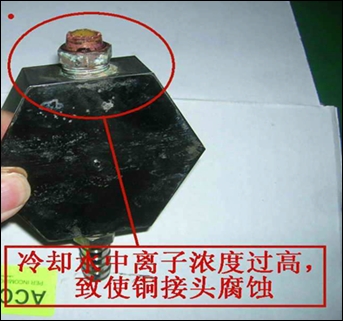- 08
- Sep
Importance of circulating water in metal smelting furnace
Importance of circulating water in metal smelting furnace
Lolobana metal smelting furnaces, the furnace body and the power cabinet have two independent water systems, an internal circulation system, an external circulation system, internal closed-circuit deionized water, and include a water-to-water heat exchanger, rectification Silicon, reactors, filter capacitors, inverter silicon, and resonance capacitors are all connected to this system. Since the internal water system circulates in the DC high voltage, the internal cooling water will generate electric ions under the action of the pipeline DC high voltage. After a period of time, the concentration of electric ions will gradually increase. When the concentration of electric ions exceeds the required value, the high DC voltage will corrode the copper joints through the cooling water with high concentration of ions, resulting in the situation seen in the photo below. If the water connector corrodes and breaks during use of the power supply, the pressurized cooling water will spray out, causing major equipment accidents, and the cooling water with high concentration of electric ions will reduce the insulation of the system, which is more likely to cause damage to the thyristor Therefore, the conductivity of the cooling water should be checked regularly, and it must be less than 10us/cm. If the conductivity is greater than 100us/cm, replace the circulating cooling water in all power cabinets, and it is recommended to replace it every six months.

There is another problem in the use of closed water cooling that should be paid attention to. The water cooling system should be equipped with an exhaust valve. However, in actual use, most of the water cooling systems without an exhaust valve are installed. When the furnace is out of service for a long time, gas is easy to enter into the water separator. When the metal smelting furnace is restarted, part of the gas will remain in the water separator and the cooling water box of the components and cannot be discharged, resulting in the failure of this component. The cooling of the circulating water causes the temperature to be too high to burn out the components. Therefore, the water-cooling system without a drain valve is not used for a long time, and it is activated again. The water clamp at the highest point of the water separator must be loosened to drain the remaining gas.
